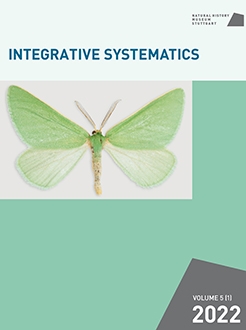A new species of Afrotropical Melittiini, Afromelittia gruschwitzi sp. n., is described. Attracted by synthetic pheromones, a single male was trapped 1992 in Abuko Nature Reserve, a gallery forest in The Gambia, West Africa. The female and the biology of the new species are unknown.
Introduction
The small genus Afromelittia was established by Gorbunov & Arita (1997) to include four very similar species of Afrotropical Melittiini, namely the type species A. occidentalis (Le Cerf, 1917) from Central Africa, A. aenescens (Butler, 1896) from Malawi, A. natalensis (Butler, 1874) from South Africa and A. iridisquama (Mabille, 1890) from Ivory Coast. A further two species, A. caerulea Bartsch, 2016 from South Africa and A. haematopis (Fawcett, 1916), widespread from the Arabian Peninsula to Kenya and Botswana, were added by Bartsch (2016). The closest relative of Afromelittia is the American genus Eichlinia Gorbunov, 2020.
In 1992, Dr. Michael Gruschwitz, a biologist and friend of the second author, carried out a zoological survey in The Gambia, West Africa, supported by the Gambian Wildlife Conservation Department. Equipped with some artificial pheromones composed for various Central European Sesiidae and with the request to try them out on occasion during the survey, he succeeded in attracting two males of a conspicuous, large Sesiidae species and caught one of them. We found that this specimen belongs to an unknown species of Afromelittia, described below.
Material and methods
The synthetic attractant used was a broad spectrum pheromone of unknown composition, developed in the 1980s for some Central European pest species and withdrawn from the market a long time ago. Terminology of the wing venation and anatomical description follows ŠPatenka et al. (1999). The specimen was photographed using a Visionary Digital photography system (LK Imaging System, Dun. Inc., equipped with a Canon EOS 5DSR camera). Genital slides were produced using standard techniques, i.e., maceration of the abdomen in a 5% potassium hydroxide solution, removal of the scales and embedding with opened valvae in Euparal (e.g., Robinson 1976). Photos of the slide were taken with a Keyence VHX-5000.
Taxonomic part
Afromelittia gruschwitzi sp. n.
(Figs. 1–2)
Type material
Holotype ♂ (Fig 1): The Gambia, Abuko Nature Reserve between Lamin and Serrekunda, 13°23′29.753″N, 16°37′02.492″W, at pheromone, 27.VII.1992, 16.00 h, leg. Dr. M. Gruschwitz. Deposited at State Museum of Natural History, Stuttgart, Germany.
Description
Partially descaled specimen. Alar expanse 33 mm, forewing 14 mm, antenna 8 mm, body length 17 mm. Head: labial palpus orange-yellow, frons laterally orange; vertex raw umber, brownish-grey between antennae; pericephalic scales dorsally raw umber, laterally orange; antenna black, reverse side orange-yellow. Thorax: pale brownish-grey, laterally grey with pearly shine, yellowish below forewing base; dorso-lateral scale tufts of meta-thorax grey, proximally white. Fore- and midleg: orange-brown; tarsus of midleg dark brown with black thorns laterally. Hindleg: dark grey; coxa grey, proximally yellow; ventral edge of femur white with grey, hair-like scales; scale tufts of tibia and first two tarsomeres black, scarcely mixed with reddish-brown; distal tarsomeres black, dorsally white; spurs black, rear side with long, reddish-brown and white scales. Wings: forewing black with some white scales, wing base with individual dark olive-green scales; external transparent area well developed, consisting of four continuously widening cells between stem of R4/R5 and CuA1. Hind-wing: hyaline; veins and narrow margins black; anal area black, upper side densely covered with white, intensely blue shining scales. All wings: underside similar, fringes dark brownish-grey. Abdomen: black, second segment laterally with green-brownish gloss. Specialized scale follicles of tergite eight largely stunted, only laterally well developed.
Genitalia (Fig. 2). Typical for the genus; tegumen with sclerotized, slightly pointed gnathos; valva with ventral margin slightly concave in middle part, basal two-fifths thickened, continuously tapering distally, dorsal margin convex, distal margin concave; saccus long, distally tapering; phallus straight, about 1.5 times as long as valva.
Diagnosis
Afromelittia gruschwitzi sp. n. resembles other species of the genus, particularly A. occidentalis, A. aenescens, A. natalensis, A. iridisquama and A. caerulea. All of these species, including the western extreme A. iridisquama, differ externally by the usually completely opaque fore-wings, which only rarely have one or two very small transparent cells near the tornus (external transparent area well developed and large in A. gruschwitzi), and the well-developed, specialized scale follicles of tergite eight (stunted in medial part in A. gruschwitzi). Afromelittia caerulea differs further by the bright blue, opaque hindwings. In the male genitalia, these species are hard to distinguish. Afromelittia gruschwitzi sp. n. has valva slightly broader and shorter with distal margin somewhat more concave, and saccus longer and narrower.
Habitat and behaviour
Two males were attracted to the pheromones during the rainy season, at 4:00 p.m. in a forest glade close to the edge of a gallery forest in transition to the surrounding savannah (Fig. 3). The type locality is situated within the Abuko Nature Reserve, which is the northernmost outpost and The Gambia's last undisturbed remaining riverine forest patch within the Guinea forest savannah biome, protected since 1916, initially as a water catchment area (Jensen & Kirkeby 1980). The reserve is a well-known biodiversity hotspot, inhabited by numerous species whose only Gambian distribution point is Abuko. It has been the subject of various scientific field studies about vertebrate and invertebrate taxa (Gruschwitz et al. 1991; Lenz 1995).
Biology
Unknown. Melittiini larvae are trophically bound to Cucurbitaceae. In The Gambia, this family is present with at least 30 species that occur both in the savannah and in the forest (Prof. Dr. E. Fischer, Koblenz, pers. comm.). The locality of collection is situated west of Dahomey Gap. For zoogeographical aspects of the area, see Schmitt (2020).
Etymology
The new species is named after Dr. Michael Gruschwitz, Weeze, North Rhine Westphalia, Germany, who collected the holotype.
Acknowledgements
We are grateful to Dr. Sigrid Lenz (Bad Kreuznach) and Prof. Dr. Eberhard Fischer(Koblenz) for information on Gambian vegetation.








